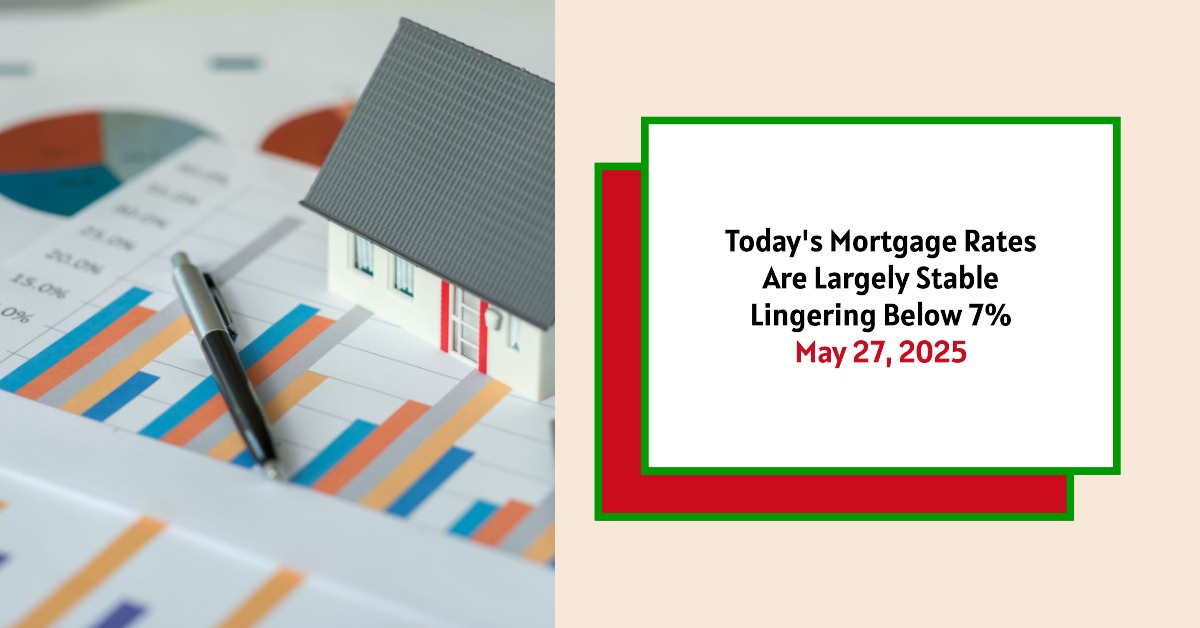As of May 27, 2025, mortgage rates have largely remained unchanged following the Memorial Day weekend, with average rates lingering below the 7% mark. The average 30-year fixed mortgage rate is currently at 6.90%, and the average 15-year fixed rate stands at 6.11%. Economists are speculating about potential future changes in rates, driven largely by recent legislative actions and overall economic trends.
Today's Mortgage Rates – May 27, 2025: Rates Are Largely Stable, Lingering Below 7%
Key Takeaways
- Current Rates: The 30-year fixed mortgage rate is 6.90%, and the 15-year fixed rate is 6.11%.
- Market Context: Rates have held steady despite initial forecasts for a decline this year.
- Legislative Influence: The GOP tax bill's passage has contributed to uncertainty in the market.
- Robust Refinance Rates: Refinance rates are reportedly higher, with the 30-year refinance fixed rate at 6.90%.
- Expectations for 2025: The Federal Reserve's stance may affect long-term rate changes throughout 2025.
Current Mortgage Rates Breakdown
As of today, the following average mortgage and refinance rates are reported by Zillow:
Mortgage Rates
| Type of Mortgage | Current Rate (%) |
|---|---|
| 30-year Fixed | 6.90 |
| 20-year Fixed | 6.72 |
| 15-year Fixed | 6.11 |
| 5/1 ARM | 6.84 |
| 7/1 ARM | 7.30 |
| 30-year VA | 6.49 |
| 15-year VA | 6.49 |
| 5/1 VA | 6.49 |
Mortgage Refinance Rates
| Type of Refinance | Current Rate (%) |
|---|---|
| 30-year Fixed | 6.90 |
| 20-year Fixed | 6.73 |
| 15-year Fixed | 6.13 |
| 5/1 ARM | 7.60 |
| 7/1 ARM | 7.46 |
| 30-year VA | 6.47 |
| 15-year VA | 6.10 |
| 5/1 VA | 6.36 |
Sources: Data compiled from Zillow.
Understanding the Current Trends in Mortgage Rates
The current state of mortgage rates is influenced by several factors, particularly the recent passing of the GOP tax bill which aims to introduce significant changes to fiscal policy. This tax information plays a crucial role as it is expected to add trillions to the national deficit, leading to potential fluctuations in interest rates. Historically, when government spending increases, it can create upward pressure on mortgage rates, which may leave homebuyers and homeowners feeling anxious about their financing options.
The impact of these governmental decisions is compounded by wider economic indicators. As inflation remains a concern across the nation, the Federal Reserve’s responses in setting interest rates can directly influence borrowing costs. When inflation rises, the Fed has historically raised rates to cool down the economy; however, in today’s uncertain climate, they have decided to keep rates stagnant. This can generate mixed feelings among consumers and investors, as they await more definitive signals regarding future movements.
What’s Next for Mortgage Rates?
Initially, experts expected mortgage rates to trend downward throughout 2025, especially as the Federal Reserve was anticipated to continue cutting rates to stimulate the economy. However, the Fed's decision to keep rates steady this month has left many uncertain about future movements. It’s unclear if they will lower rates or maintain the status quo.
Investors and economists alike are watching how the forthcoming legislative developments will impact both the economy and the mortgage landscape. According to the CME FedWatch tool, there's a 94% chance that the federal funds rate will remain unchanged during the Fed's upcoming meeting in June. This typically indicates a cautious approach to monetary policy, limiting any dramatic shifts in mortgage rates in the near future.
An Example Calculation: What Does This Mean for Home Buyers?
To illustrate how these rates translate into real-world costs, let’s consider a $400,000 mortgage loan. For a 30-year fixed mortgage at 6.90%, the following calculation comes into play:
- Monthly Payment: Approximately $2,634
- Total Interest Paid over the 30 Years: Roughly $548,384
Now, if a borrower were to choose a 15-year fixed mortgage at 6.11%:
- Monthly Payment: Approximately $3,399
- Total Interest Paid over 15 Years: About $211,864
As we can see, choosing between a 30-year and a 15-year mortgage substantially impacts both monthly payments and overall interest expenses. For instance, while a 15-year loan will result in a higher monthly payment, overall interest payments are dramatically lower than they would be with a 30-year mortgage.
Fixed-Rate vs. Adjustable-Rate Mortgages
In the mortgage world, borrowers often face a choice between fixed-rate and adjustable-rate mortgages (ARMs).
- Fixed-Rate Mortgages: A fixed-rate mortgage guarantees a set interest rate for the life of the loan. This predictability is highly valued by many borrowers, especially in a fluctuating market. For example, borrowers who secured a 30-year fixed mortgage earlier may find their overall home budget easier to predict, despite market changes that lead to increased rates for new buyers.
- Adjustable-Rate Mortgages (ARMs): An ARM maintains a low initial rate for a specified time (e.g., the first five or seven years), after which the rate adjusts based on the broader economic conditions. Currently, ARMs are being reported at slightly higher rates compared to fixed mortgages; for example, the 7/1 ARM is currently at 7.30%.
While ARMs can offer initial savings, risks exist. If rates climb sharply after the initial low period, homeowners may find themselves making significantly higher payments. This uncertainty calls for careful consideration of the applicant's long-term financial strategies.
Expectations for the Future of Mortgage Rates
Looking ahead, most economists predict that mortgage rates won’t see drastic reductions until late in 2025. Following a moderate decline in 2024, rates are projected to stabilize, with averages hovering around 6.1% for 30-year fixed mortgages by 2026, down from the current levels.
Fannie Mae's forecast has outlined expectations of a slight increase in home sales, projecting 4.92 million sales for 2025 as more buyers opt to enter the market now rather than wait for potentially lower rates in the future. The anticipated uptick in home sales suggests that buyers might be adjusting their expectations in light of current economic realities.
Freddie Mac also mentions that while buyers were previously holding off for lower rates, more activity is expected as the uncertainty prompts people to act sooner. The report indicates that while sales numbers may not match up with historical averages, an increase compared to last year signals a more proactive market.
Read More:
Mortgage Rates Trends as of May 26, 2025
Dave Ramsey Predicts Mortgage Rates Will Probably Drop Soon in 2025
The Bigger Picture: Economic Influences on Mortgage Rates
Understanding mortgage rates is not just about numbers; it is essential to grasp how macroeconomic factors influence these rates. Broad economic indicators — including unemployment rates, consumer confidence, and inflation stats — also affect lending decisions. For instance, if inflation remains higher than desired, the Fed may choose to increase interest rates to counterbalance the inflation trend, ultimately affecting mortgage rates.
Moreover, lender competition affects mortgage prices. As banks vie for customers, they may offer lower rates or more flexible terms. However, these promotions can be fleeting and heavily influenced by shifting market conditions. Thus, staying informed about lender practices and rate trends is crucial for consumers aiming to secure favorable financing.
Current Market Dynamics and Their Implications
The current mortgage market dynamics bring both challenges and opportunities for homebuyers and those looking to refinance. Despite rates mainly holding steady, the underlying factors affecting these rates — legislative measures, Federal Reserve decisions, and economic indicators — paint a complex picture that requires diligence and research from anyone planning to make a significant financial commitment.
With many buyers and homeowners weighing their options, tools such as mortgage calculators can assist in visualizing how changing rates and loan terms can impact overall finances.
Cautious Optimism: Moving Forward
Despite uncertainty surrounding the trajectory of mortgage rates, there is also cautious optimism among experts. If inflation eases and the economy stabilizes, we could eventually see a decline in rates, which may foster a healthier housing market. However, these trends are contingent on numerous factors, including geopolitical events, economic growth patterns, and how closely the Fed is monitoring these changes to adjust lending rates accordingly.
The anticipation of what comes next keeps everyone on their toes in this interesting market, and in such a financially consequential arena, being well-informed can make all the difference.
Invest Smarter in a High-Rate Environment
With mortgage rates remaining elevated this year, it's more important than ever to focus on cash-flowing investment properties in strong rental markets.
Norada helps investors like you identify turnkey real estate deals that deliver predictable returns—even when borrowing costs are high.
HOT NEW LISTINGS JUST ADDED!
Connect with a Norada investment counselor today (No Obligation):
(800) 611-3060
Also Read:
- Will Mortgage Rates Go Down in 2025: Morgan Stanley's Forecast
- Expect High Mortgage Rates Until 2026: Fannie Mae's 2-Year Forecast
- Mortgage Rate Predictions 2025 from 4 Leading Housing Experts
- Mortgage Rates Forecast for the Next 3 Years: 2025 to 2027
- 30-Year Mortgage Rate Forecast for the Next 5 Years
- 15-Year Mortgage Rate Forecast for the Next 5 Years
- Why Are Mortgage Rates Going Up in 2025: Will Rates Drop?
- Why Are Mortgage Rates So High and Predictions for 2025
- Will Mortgage Rates Ever Be 3% Again in the Future?
- Mortgage Rates Predictions for Next 2 Years
- Mortgage Rate Predictions for Next 5 Years
- Mortgage Rate Predictions: Why 2% and 3% Rates are Out of Reach
- How Lower Mortgage Rates Can Save You Thousands?
- How to Get a Low Mortgage Interest Rate?
- Will Mortgage Rates Ever Be 4% Again?


